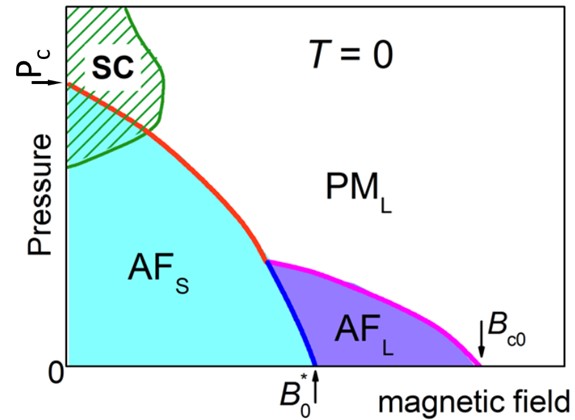Mapping multiple quantum transitions in heavy fermion compounds
Using extremely high-field magnet capabilities available at the National High Magnetic Field Laboratory in Tallahassee and at the Pulsed Field Facility in Los Alamos in USA, an international research team, led by Prof. Huiqiu Yuan from the Center for Correlated Matter and Department of Physics at Zhejiang University, has discovered two distinct classes of zero-temperature transitions called quantum critical points (QCPs). The study provides significant progress toward deriving a universal phase diagram for QCPs.
This work is important for understanding and developing theories about materials whose electronic and magnetic properties are controlled by quantum fluctuations that develop because of Heisenberg’s uncertainty principle. One important property that can emerge is unconventional superconductivity, which appears when a magnetic transition is tuned to zero temperature by applying pressure. The heavy fermion compound CeRhIn5 and related materials display quantum-driven continuous phase transitions at absolute zero temperature, but scientists have not been unable to pin down whether these phase transitions exhibit universal behaviors, in an analogous way to the conventional, thermally driven phase transitions.
In a paper published online at Proceedings of the National Academy of Sciences of the United States of America on January 5th, 2015, the researchers from Zhejiang University and several other institutions report the first observation of a sharp Fermi surface reconstruction while applying a strong magnetic field to suppress the magnetic transition in CeRhIn5 to zero temperature. These experiments demonstrate that direct measurements of the Fermi surface can distinguish theoretically proposed models of quantum criticality and point to a universal description of quantum phase transitions.
The researchers took measurements of heat capacity, Hall resistivity and de Haas-van Alphen (dHvA) oscillations at low temperatures across a field-induced antiferromagnetic QCP (Bc0≈ 50 T) in the heavy-fermion metal CeRhIn5. They detected a sharp, magnetic-field-induced change in Fermi surface at B0*≈ 30 T, well inside the antiferromagnetic phase. This sharp change is not expected at a usual type of QCP. Comparisons with electronic-structure calculations and properties of the closely related material CeCoIn5 suggest that the Fermi-surface change at B0* is associated with a localized to itinerant transition of the Ce-4f electrons in CeRhIn5. Taken in conjunction with earlier pressure experiments, their results demonstrate that at least two distinct classes of QCPs are observable in CeRhIn5, one with applying pressure and others with applying a magnetic field. This is consistent with the theoretically predicted universal phase diagram which tells researchers that the two classes of QCPs are connected, but this will be tested in future experiments that use simultaneously high pressures and very high magnetic fields in the High Magnetic Field Laboratories.
The collaboration included researchers from Zhejiang University, Los Alamos National Laboratory, Florida State University and Rice University in USA, Sungkyunkwan University in South Korea and Max Planck Institute for Chemical Physics of Solids in Germany,
Work at Zhejiang University was supported by National Basic Research Program (973 Program), Natural Science Foundation, the Fundamental Research Funds for the Central Universities and Zhejiang Provincial Natural Science Foundation.
Reference:
Fermi surface reconstruction and multiple quantum phase transitions in the antiferromagnet CeRhIn5, Lin Jiao et al., PNAS Early Edition, www.pnas.org/cgi/doi/10.1073/pnas.1413932112.
Technical contact:
Prof. Huiqiu Yuan, Email: hqyuan at zju.edu.cn

Figure: Schematic pressure-magnetic field phase diagram at zero temperature. Experimentally determined QCPs at Pc, B0* and Bc0 are compared to a multi-parameter theoretical phase diagram illustrated by the solid curves. SC: superconductivity. AF: antiferromagnetism with small (s) and large (L) Fermi surfaces. PML: magnetically disordered with large Fermi surface.



